Of and Concerning the plots and machinations of the Keltoi Genteel Builders.
Chapter One : Of and Concerning the ruling of the KGB
The KGB has had a tumultuous ruling history. Six main
factions have been vying for power since the dawn of time. The alliances and plotting have been such that these
factions have obtained roughly equals amounts of time in which they have controlled the KGB.
Unlike many other cultures and governments where such machinations endure, the six
factions have several traits in common.
1. They all share a love of creating new towns where they can hide when another
faction comes to power.
2. They are all obsessed with building monuments and statues of themselves.
3. The basically agree that most other cultures are unworthy to share the world and should be subsumed into the KGB.
4. They all share a fundamental contempt for the KGB population and will force them to do their bidding at any cost, including lives.
5. A complete refusal to consider trying any other form of rule that would not form them into a true community.
Because of these fundamental agreements, this narative will not concern itself with the individual factions, but rather will treat the six
factions as a single unit.
Chapter Two : Of and Concerning the Foundations of the KGB Hegemony
Awash on the shores of a landmass that was rumored to be massive and monolithic, the initial tribe of the KGB was faced with the task of selecting a place from which to orchestrate the KGB Hegemony.
Knowing that the six
factions would never agree to any more enlightened way of rule, the KGB decided to attempt to found as many river settlements as possible. In pursuit of this goal, quick access to a plentiful source of food was paramount.
Consequently the town of Entremont was founded on the river Aedui just 100 miles southwest of an expansive grassland where there were expansive fields of grain available for transport to the city.
All early focus was on growth as the various
factions attempted to found places where they could hatch plots out from under the eyes of whichever
faction currently controlled the KGB. Because of the urgency of these plots the new towns were founded quite close to Entremont. It would not be till much later that any cities would be founded far away.
All KGB efforts at this point were focused on creating roads and exploiting as many of the rivers and food sources as could be located.
Chapter Three : Of and Concerning the Early Foreign Policy of the KGB
In 2950 BC the KGB first encountered another culture in the form of the Mogols led by the rat Temujin. Due to internal struggles, the KGB would not take care of this issue for a while, but instead continued their goal of continued expansion.
By 2550 BC the KGB was aware of another tribe to the east across the Kattegat Straits, but despite the rumors contact was not made for 500 more years. At that time the tribe was revealed as Japan.
In 2110 BC a travelling warrior named Conan encountered the Chinese people to the north-west. Not much would occur for a while.
In 1830 BC Conan's brother Thor encountered the nation of Carthage to the west of the Mongols. Not much else would be encountered before the next great age of the KGB.
In 1575 BC A curragh commanded by Eric met the Indians. Ghandi was an upstanding man and would turn out to be a close friend of the KGB for a long time.
In 1125 BC contact was made with the Iroquois. A backward people who would never amount to much in to world.
Chapter Four : Regrouping and building a new plan
The KGB was attempting to build many small cities. They planned to take maximum advantate of a temple to a heathen Greek Goddess. (Though noone in the world could figure out where the concept of this Artremis had come from since no known culture would admit to worshiping her.)
Word came from afar that a people called Babylonians had build a complex of stone buildings called Pyramids in which they could store massive amounts of grain. The next few years were dominated by information that the French had built a statue of another unknown god named Zeus.
The news kept on pouring in as a far off mysterious culture of Scandinavia continued to build a city unparalleled in the world. They Built a Giant Bronze Statue to straddle their harbor, A giant stone tower to guide thier ships and followed it on by building a temple to the very goddess that the KGB had decided to honor.
Meanwhile the welcome new arrived that the nation of China had build a large building in which to store books, stolen from the other nations.
The KGB was forced to abandon the plan of getting the Temple and began building temples to their own gods in every town. Many citizens perished in the haste to complete such projects.
Chapter Five : Of and Concerning the age of the Sword
By 1000 BC the KGB Hegemony had swollen to 16 Towns and was starting to run out of room to build. They had also amassed a large treasury in preparations for outfitting their warriors with swords.
In 590 BC a large force of Gallic Swordsmen marched into China, sweeping everything out their way. After liberating much of China (including the Book Repository) the force, along with a new force of Swordsmen from the area around Entremont decended upon the Mongols. As these forces finished off the Mongols, Entremont and the surrounding cities built a large force of
Swords to invade the Eastern Empire of Japan.
Japan had been at war with the Iroquois for several hundred years, so it was expected that their backside would be vulnerable. Unfortunately, Japan was able to provide far more resistance than the KGB had hoped.
After rushing through the Mongols the Western force regrouped and proceeded to stomp into the lands of Carthage, turning north into the Carthaginian penninsula.
Soon the entire south was covered in Green, a sight that was beautiful to the KGB. Temples and Libraries were hastilly constructed in all new territories. The intent was to fill them in, with many closely built towns, but the empahsis on Soldiers was such that production of Town building crews was curtailed.
Chapter Six : Of and Concerning the Age of the Knight
The end of the Quest to dig the Carthaginian rats out of their lairs was finished after the advent of Chivalry and thus was performed by powerful soldiers who were nominated at the whim of the KGB.
After that the KGB ordered troops to Destroy the Iroquois. After a short and rather painless war the Iroquois were reduced to two cities. Only one of which was known to the KGB. Thus they made peace. A Right of Passage was signed with India so they could pursue war with the Vikings, but by the time the KGB arrived, France and India had pretty much destroyed Ragnar. The KGB was, however able to capture Trondheim with its bevy of Wonders.
After this a short war was fought against America. During this time the KGB regained some focus and started concentrating on filling in all availiable space with towns. In each one of these temples and libraries are being rushed at the time of this narrative.
Chapter Seven : Of and Concerning the foreign Governements
China: Weak and wiped early. They still exist as a 1 tile island.
Mongolia: Not much better. A fairly easy conquest.
Japan: A tough egg to crack, but not really hard. We made sure to take them before they could build Samurai, but they lasted a lot longer and put up a better fight than expected.
Carthage: A pesky tribe, too concentrated on defense to pose an offensive threat, but but certainly painful to dig out of their positions.
India: A powerful nation. Ghandi has been our friend for a long time. He may continue in this role. (Or maybe not)
Iroquois: They were gassed by the time the KGB troops finished with Carthage. War with India had reduced them to easy fodder for a force of Gallic Swordsmen and Knights.
Babylon: Powerful start, but they fell to mediocrity under the combined forces of most of the rest of the world. Strange that they should incite fury in so many other nations.
France: Big and powerful. They were the only nation that had a chance to get to 50K culture before the KGB hit 100K. Strangely absent from the wonder building races though.
Vikings: An Early power. Trondheim eventually had Colossus, Great Lighthouse, Sun Tsu's Art of War, Leonardo's Workshop and the Temple of Artremis. In the late Middle ages they were virtually wiped out by a the combined might of France, India and America.
America: They stood tall and looked like a power. Their research capability kept pace with the rest of the world. For some reason though they never seemed scary.
England: Very little contact has existed between Elizabeth and the KGB. They seem to be content to leave each other alone.






 And that's all I'll say about it now.
And that's all I'll say about it now.
 T
T was the capture of Salamanca with both The Pyramids and Sun Tzu's. These two "universal" Wonders tremendeously eased our future game progress. Our knights crushed the remaining Iroquois forces, trashed the Indians, and destroyed China. Upgraded to cavalry, they entered the war against Carthage, which lasted well into the Industrial Age.
was the capture of Salamanca with both The Pyramids and Sun Tzu's. These two "universal" Wonders tremendeously eased our future game progress. Our knights crushed the remaining Iroquois forces, trashed the Indians, and destroyed China. Upgraded to cavalry, they entered the war against Carthage, which lasted well into the Industrial Age.

 We traded for Pottery from China to allow a granary build. Entremont built warrior, archer (to go after the barbs), warrior, granary, 6-turn warriors/settlers forever. We contacted the southern civs one at a time, then in 1575 BC Mapmaking appeared on the trading screens and we traded for most of the map, all of the contacts, and close to tech parity. We traded our way into the Middle Ages in 1000 BC.
We traded for Pottery from China to allow a granary build. Entremont built warrior, archer (to go after the barbs), warrior, granary, 6-turn warriors/settlers forever. We contacted the southern civs one at a time, then in 1575 BC Mapmaking appeared on the trading screens and we traded for most of the map, all of the contacts, and close to tech parity. We traded our way into the Middle Ages in 1000 BC. .
.



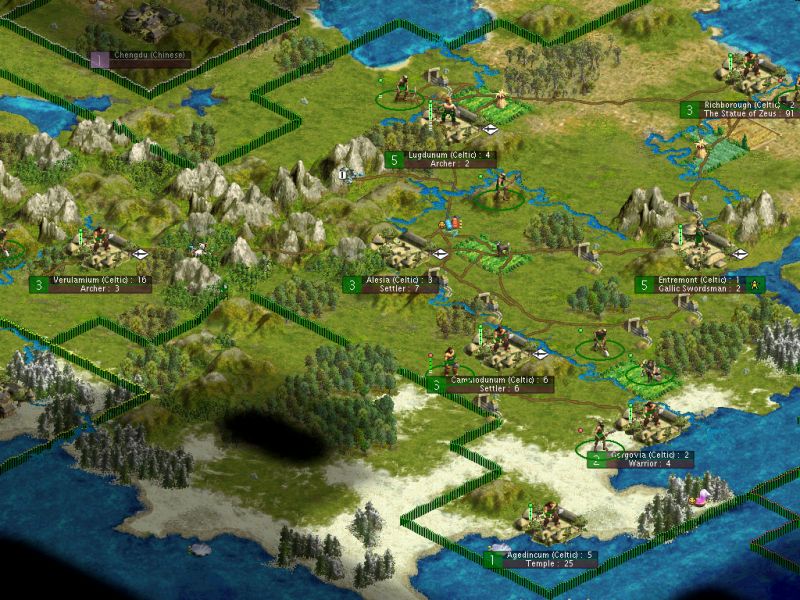
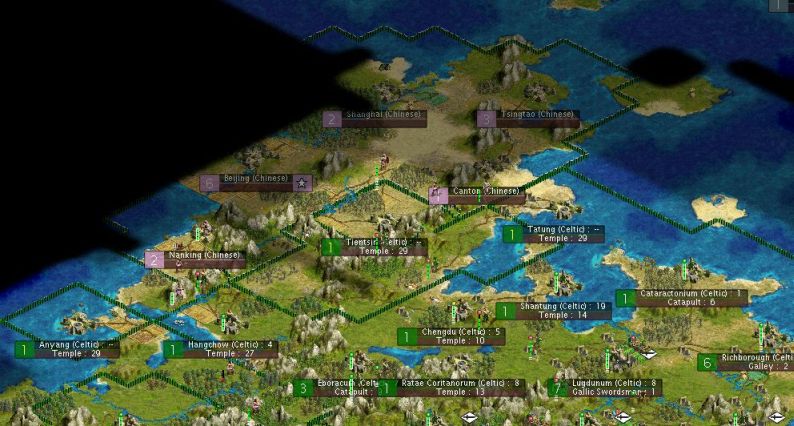
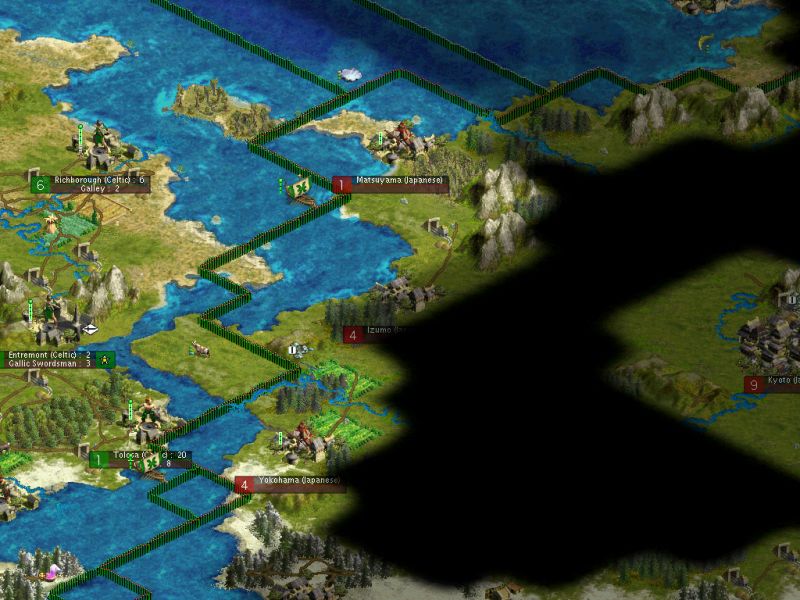
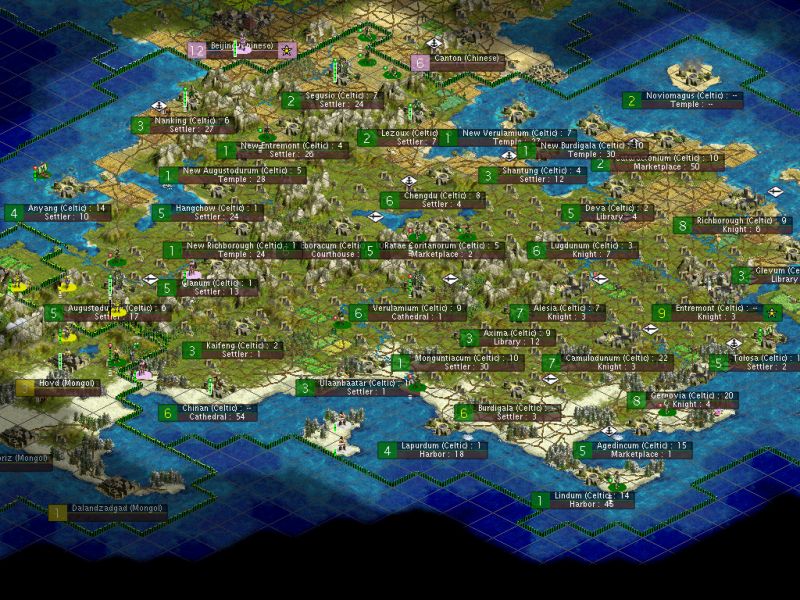
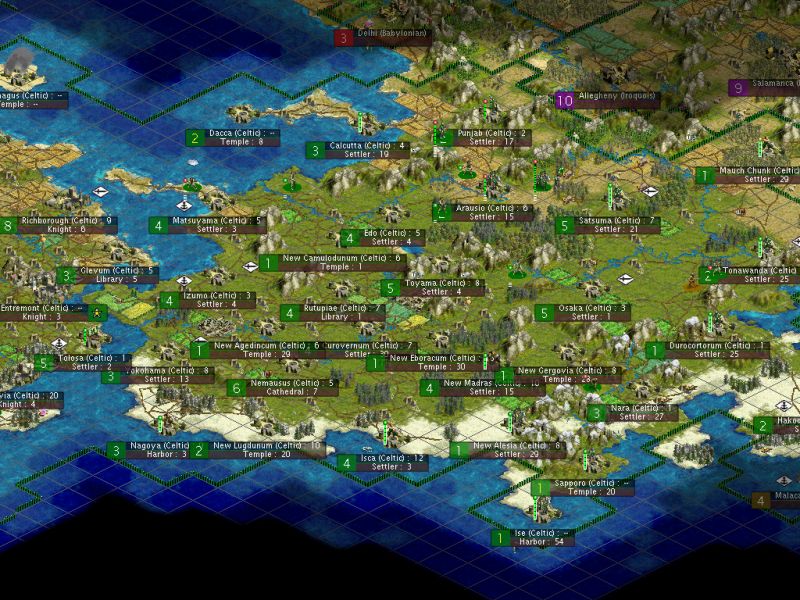





 ) prevented that.
) prevented that.